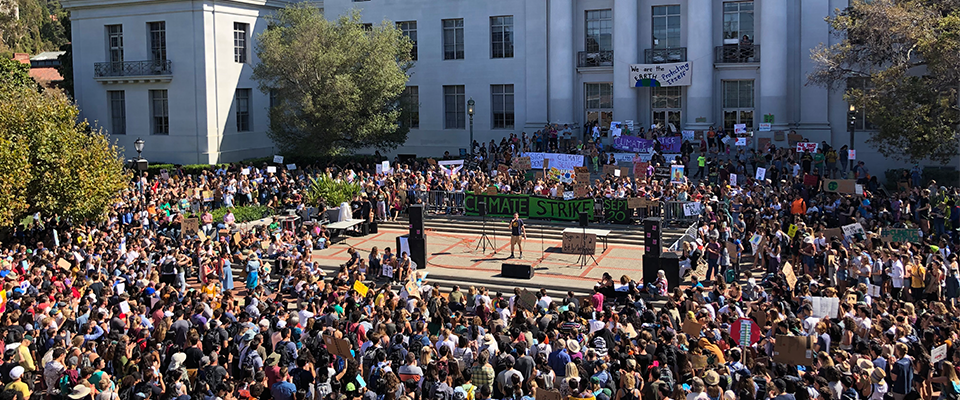True, climate change could very well be the end of us—but until then, it could also create some fabulous economic opportunities. Understandably, it behooves responsible investors to assess the specific risks of climate change to their portfolios. Given that much of Florida seems threatened by climate change-induced sea level rise, for example, you wouldn’t want to put money in Miami real estate investment trusts. Or would you?
Actually, it turns out you might.
“Depending on when you do it, it could still be a smart move,” says Emilie Mazzacurati, the founder and CEO of Four Twenty Seven, a Berkeley-based research firm that provides climate change risk analyses for about 35 banks, investment managers, corporations, and government institutions.
Four Twenty Seven doesn’t research climate change directly, says Mazzacurati. “We take existing data and transform and repackage it, making it useful for business.”
Named after California’s 2020 annual carbon emissions target of 427 million metric tons, Four Twenty Seven helps investors assess an uncertain future. It is one of a growing number of firms, including large research providers such as Rhodium Group, parsing climate change risk. But Mazzacurati says her Berkeley shop differs from her competitors in the specificity of its purview.
“Our focus is strictly on climate change, and we were first to market,” says Mazzacurati, who got her Master’s in Public Policy from Goldman. (The firm’s chief operating officer and chief development officer are also Cal alumni.) “Our analytics are leading the field, and we think that’s going to remain the case for the foreseeable future.”
That said, Four Twenty Seven doesn’t research climate change directly. “We don’t produce scientific data,” Mazzacurati says. “We’re conflators. We take existing data and transform and repackage it, making it useful for business.”
Most of the raw data comes from climate change models developed by governments, universities, or research institutions. More than 40 such models are in use, says Mazzacurati, and Four Twenty Seven draws from a subset of 18. Climate change models have become highly sophisticated in recent years thanks to artificial intelligence and machine learning algorithms, and the level of detail they provide is astonishing: Some can predict weather and temperature for a specific place at a specific date 60 years in the future, for example.

But Four Twenty Seven is looking for large trends “not the weather for specific dates,” says Mazzacurati. “So we extract this data—a huge amount of data, terabytes of data—and apply our own methodologies to develop risk indices for specific areas—where do we see the characteristics of major events [e.g., flooding, sea level rise, excessive heat] developing.”
While people of conscience may care about the really long-term implications of climate change, many investors do not. They’re mainly concerned about conditions five to twenty years out, says Mazzacurati, “So for their purposes—and our purposes—2100 isn’t relevant.”
Take Miami, for example. With most climate change models predicting that much of the city will be submerged in a century or so, any nominally savvy investor might shy away from south Florida real estate, regardless of time frame. But, says Mazzacurati, no one invests that way.
Still, she adds, the bottom line is that the risks are real and will continue to grow, “so the challenge for us is in overlapping climate change timeframes with the investment timeframes of investors.”
Four Twenty Seven attempts to meet that challenge through proprietary “data products” such as its global dataset on climate change exposure for real estate investment trusts (or REITs—typically investment funds comprised of rental properties). This analysis evaluates more than 300 international REITS and 73,000 separate properties held by those trusts, assigning numeric risk scores based on vulnerability to heat stress, water stress, floods, sea level rise, and hurricanes or typhoons. Hazards are projected to 2040, and subscribers get quarterly updates and can customize their searches through an interactive dashboard.
Investment is a fraught game even without climate change, says Mazzacurati. “But increasingly, corporations and investors are taking it into account. There’s a growing realization it’s a necessity.”
In the simplest terms, a high number is bad, a low number is good. Or better, at least. And using the dataset, some REIT properties look decidedly dicey.
A Fukoka REIT shopping center, for example, gets a red flag for extreme typhoon threats (100 out of 100 points), sea level rise (80 points) and floods (88 points). A residential complex owned by Stockland, an Australian REIT, also is red flagged, albeit at a lower level, for flood risk (79.7 points) and water stress (58 points). But another Stockland project, an assisted living facility, is green zoned with scores well below 50 points across the board.
For the most part, the investment community is responding positively to the assessments.
“We’ve been concerned about climate change risk for quite a while,” says Laura Craft, the head of global sustainability at Heitman LLC, a Chicago-based real estate investment firm, “but we always had to rely on government mapping—the Tier One hazard maps put out by the State of California, for example, or FEMA maps for flooding and hurricane risk. And they just don’t provide enough granular detail.”
Craft notes that such maps usually evaluate risks on a county-by-county basis rather than more local conditions. And that’s problematic: Apartment buildings that face each other across county lines, for example, could endure the same flood risk even though FEMA may consider one county high risk and the other low risk.
“But Four Twenty Seven uses multiple indicators at a much finer geographical scale, and their analyses are updated far more often,” says Craft. “FEMA only redraws their maps every three to five years. Also, FEMA isn’t immune to political pressure. Some FEMA maps have been stalled by developers who didn’t want their properties to end up in a new [higher risk] zone.”

While Craft finds Four Twenty Seven’s products valuable, she emphasizes investors must still do their own due diligence.
“Four Twenty Seven gives you locational scores, but they don’t always take into account what is being done to mitigate risk,” Craft says. “For example, there are locations in Japan that are at high cyclone risk, but many of the properties are over-engineered so they suffer little damage when cyclones come through. The same with flood zones—some of the properties can be elevated, and that reduces risk. So while the Big Data products we get from Four Twenty Seven are valuable tools, we also use third party consultants and local experts to evaluate all possible investments.”
If that all sounds challenging, it’s because it is, says Mazzacurati. Investment is a fraught game even without climate change, “and clients can really struggle with this additional element they have to consider. But increasingly, corporations and investors are taking it into account. There’s a growing realization it’s a necessity.”
And that’s not strictly due to concerns over returns on investment. Liability is also a source of anxiety. Mazzacurati observes lawsuits already have been filed against corporations that produce CO2 emissions and agencies involved in CO2 regulation. No suit of any significance has yet been decided in favor of the plaintiff, but if and when one does, “that could open the floodgates for suing over predictable risk exposure.”
Still, she says she’s encouraged to see that “the financial sector is starting to take climate change and greenhouse gas emissions very seriously. In the absence or even rollback of U.S. regulations, it’s investors who are driving change. In effect, they’re holding the corporations to account.”





















